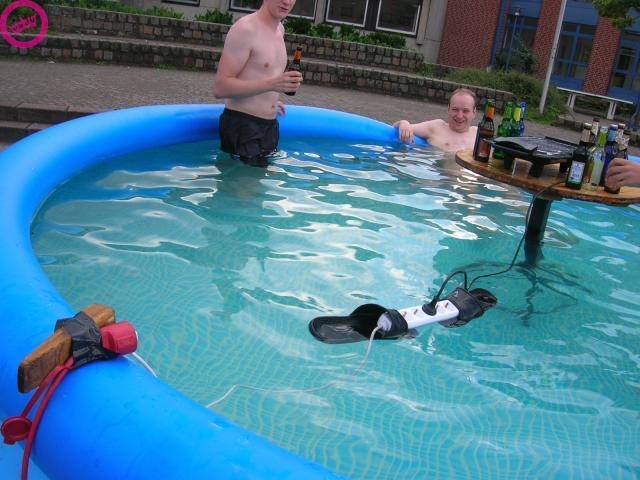Warning - Aquarium Air Lines Are Great Accidental Siphons
Originally, my plan was to put together a circuit tonight so I had an excuse to post a picture of my new lab. I'm pretty much moved in to the new apartment; only the lab space needs straightening up at this point. I drew up a circuit last night and was going to breadboard it when I left work today. I went to bed at 2:30 AM.
When I woke up at 7:35 AM for work, the aquarium sounded like a waterfall. Anyone with an aquarium knows that means the water level is too low. The output of my filter is supposed to be submerged. I immediately started checking for leaks, but I found none. Then I noticed a damp spot on the carpet in front of my desk. My mouse pad was dripping. Then, I started taking everything off my desk in a panic. My PC and UPS are next to the aquarium. Bad things could have happened.

(Image source)
Filtration
I had a Marineland Penguin 150 filter on my 20 gallon tank. It didn't keep the water very clean. There are two flaws in its design.
- Although it claims that it pumps 150 gallons/hour, some of that water flows over the filter cartridge rather than through it, meaning dirty water was flowing back into the tank.
- Because its return mechanism is a to lightly pour the water back into the tank, meaning that there isn't any real current flow. Any waste on the opposite side of the tank was never carried to the filter. I had to clean the gravel myself much more than I should need to. I was practically the aquarium's true filter.
- A gripe that doesn't count: It can be a pain to prime.
I decided to finally break down and buy a better filter. I bought a Marineland HOT Magnum 250. So far, it has solved all of my problems with the Penguin. There's just one thing missing: biological filtration.
Every aquarium requires three types of filtration: mechanical, chemical, and biological. The mechanical filter is usually some type of fabric. It acts as a strainer, blocking and trapping fish poo so it doesn't re-enter the aquarium. The chemical filter is usually activated charcoal. It removes any waste that is dissolved in the water. Live plants can also help with this. The biological filter can come in multiple forms, but they all involve growing good bacteria converts disease-causing ammonia and nitrites into safe nitrates. These bacteria need oxygen, so biological filters come in the forms of a spinning wheel, tidal foam, or gravel and an air pump. There's a good explanation at http://faq.thekrib.com/filters.html.
What Happened
My new filter doesn't contain a wheel like my old filter, so I bought an undergravel filter. It should help water flow through the gravel, allowing the bacteria to do its job. A also bought an air stone to help. What I didn't know was that I needed a stronger air pump than the one I have. I disconnected the air stone, intending to buy a stronger pump and tubing connectors today. I left the air line connected to the stone in the tank. Through the night, the airline started a slow siphon, causing everything on my desk to become soaked. This morning, I pinned it up on the wall.

Moral of the Story
Air lines can easily become water lines. Although there was no siphon when I went to bed, it formed anyway. Keep your air lines (and air pump) above the aquarium! In the 5 hours I was asleep, 2-3 inches of water siphoned out of my 1 ft x 2 ft aquarium. That's 2.5-3.7 gallons of water. Accounting for gravel, that's about 17% of the water. If this had happened on a weekend that I wasn't home, my fish would have been dead, and my computer equipment would have been destroyed.
